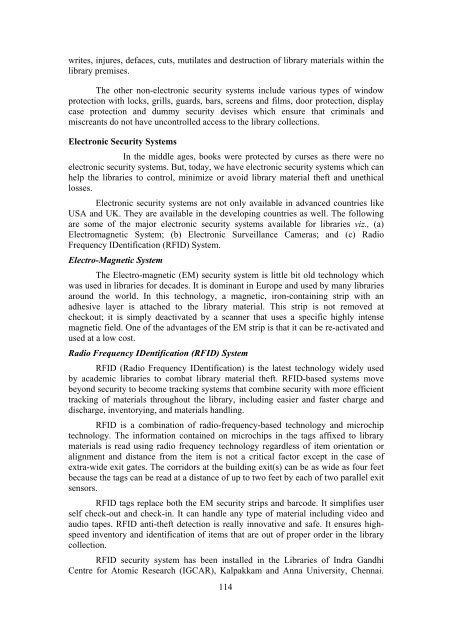READIT-2007 - Indira Gandhi Centre for Atomic Research
READIT-2007 - Indira Gandhi Centre for Atomic Research
READIT-2007 - Indira Gandhi Centre for Atomic Research
You also want an ePaper? Increase the reach of your titles
YUMPU automatically turns print PDFs into web optimized ePapers that Google loves.
writes, injures, defaces, cuts, mutilates and destruction of library materials within the<br />
library premises.<br />
The other non-electronic security systems include various types of window<br />
protection with locks, grills, guards, bars, screens and films, door protection, display<br />
case protection and dummy security devises which ensure that criminals and<br />
miscreants do not have uncontrolled access to the library collections.<br />
Electronic Security Systems<br />
In the middle ages, books were protected by curses as there were no<br />
electronic security systems. But, today, we have electronic security systems which can<br />
help the libraries to control, minimize or avoid library material theft and unethical<br />
losses.<br />
Electronic security systems are not only available in advanced countries like<br />
USA and UK. They are available in the developing countries as well. The following<br />
are some of the major electronic security systems available <strong>for</strong> libraries viz., (a)<br />
Electromagnetic System; (b) Electronic Surveillance Cameras; and (c) Radio<br />
Frequency IDentification (RFID) System.<br />
Electro-Magnetic System<br />
The Electro-magnetic (EM) security system is little bit old technology which<br />
was used in libraries <strong>for</strong> decades. It is dominant in Europe and used by many libraries<br />
around the world. In this technology, a magnetic, iron-containing strip with an<br />
adhesive layer is attached to the library material. This strip is not removed at<br />
checkout; it is simply deactivated by a scanner that uses a specific highly intense<br />
magnetic field. One of the advantages of the EM strip is that it can be re-activated and<br />
used at a low cost.<br />
Radio Frequency IDentification (RFID) System<br />
RFID (Radio Frequency IDentification) is the latest technology widely used<br />
by academic libraries to combat library material theft. RFID-based systems move<br />
beyond security to become tracking systems that combine security with more efficient<br />
tracking of materials throughout the library, including easier and faster charge and<br />
discharge, inventorying, and materials handling.<br />
RFID is a combination of radio-frequency-based technology and microchip<br />
technology. The in<strong>for</strong>mation contained on microchips in the tags affixed to library<br />
materials is read using radio frequency technology regardless of item orientation or<br />
alignment and distance from the item is not a critical factor except in the case of<br />
extra-wide exit gates. The corridors at the building exit(s) can be as wide as four feet<br />
because the tags can be read at a distance of up to two feet by each of two parallel exit<br />
sensors.<br />
RFID tags replace both the EM security strips and barcode. It simplifies user<br />
self check-out and check-in. It can handle any type of material including video and<br />
audio tapes. RFID anti-theft detection is really innovative and safe. It ensures highspeed<br />
inventory and identification of items that are out of proper order in the library<br />
collection.<br />
RFID security system has been installed in the Libraries of Indra <strong>Gandhi</strong><br />
<strong>Centre</strong> <strong>for</strong> <strong>Atomic</strong> <strong>Research</strong> (IGCAR), Kalpakkam and Anna University, Chennai.<br />
114

















